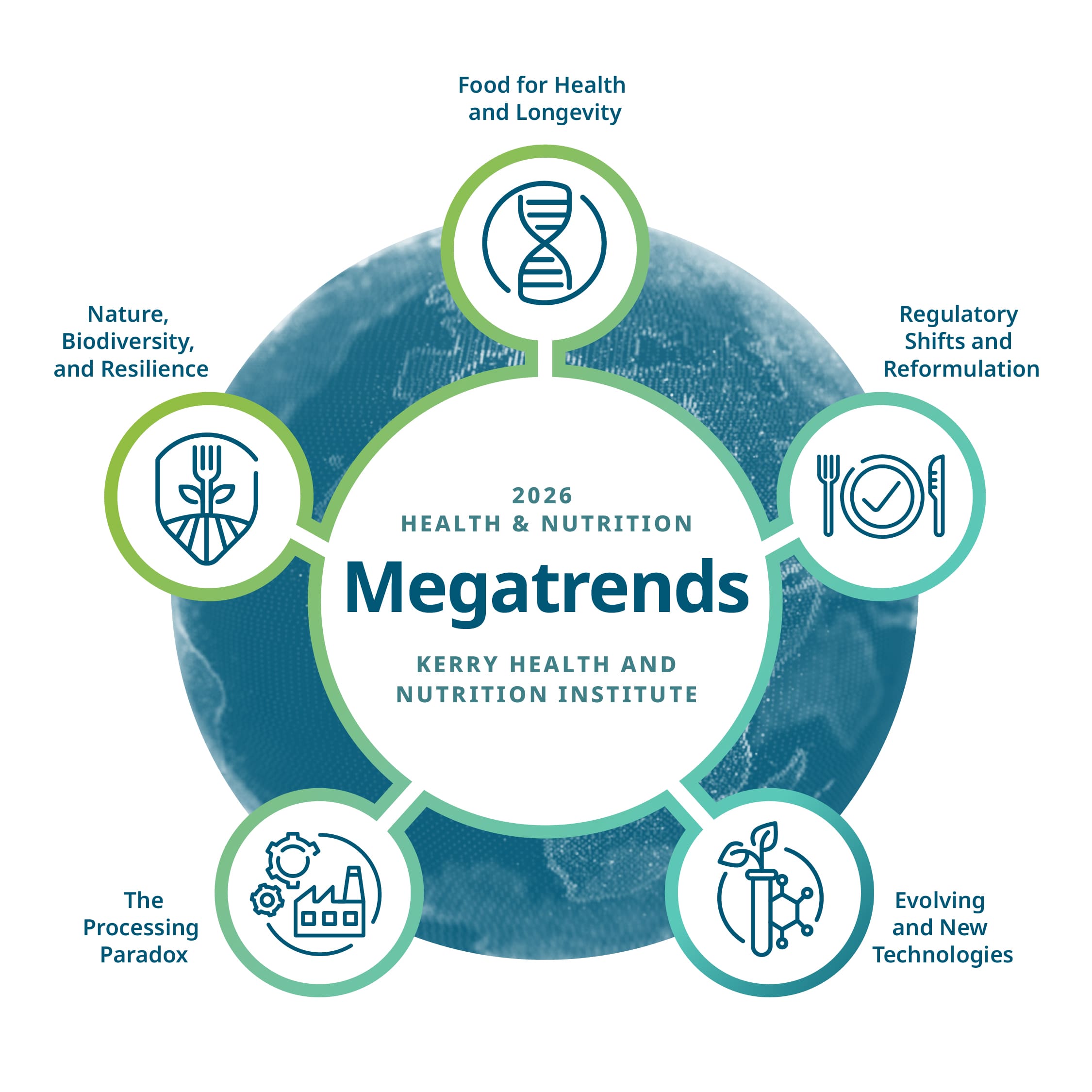The consumption of meat has and continues to be important for human progress. As we enter the midpoint of the 21st century it has become apparent that more sustainable meat sources are needed to supply food for the 8 billion plus global population. Cultivated meat is expected to be an important contributor towards this progress. But what is cultivated meat? How will it be important for human progress? Will it be the same as conventional meat? And when will it be a reality?
What is cultivated meat?
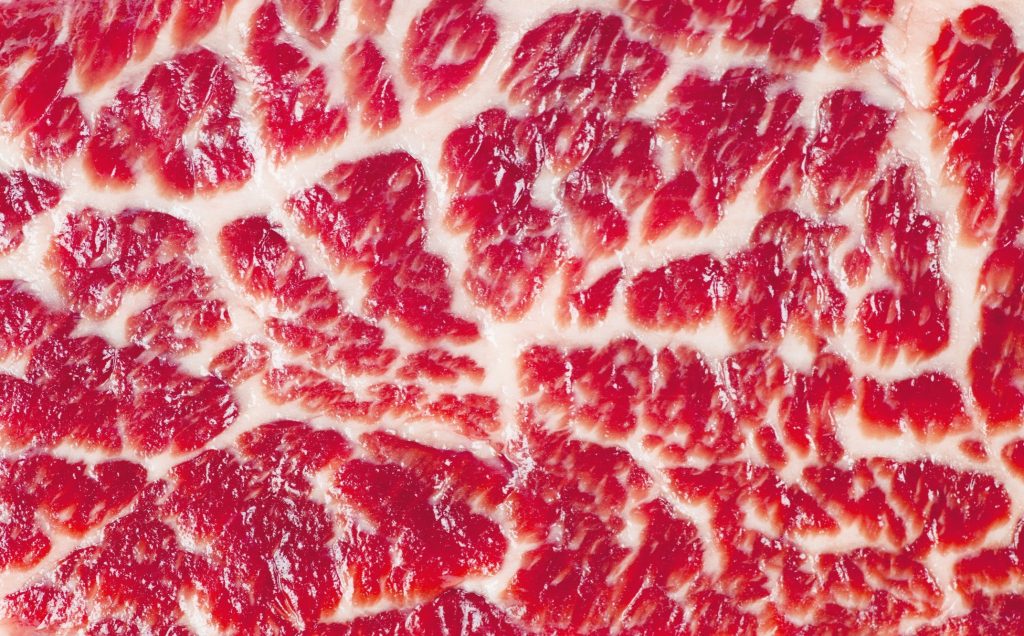
Cultivated meat is defined as the production of muscle and fat tissue from cells that are grown in vitro or outside of a living organism under controlled conditions to yield a protein-rich tissue. Dating back to 2013, the public first grasped knowledge of cultivated meat when a burger made from cells grown in a laboratory was tasted by a panel of judges on live television. Prepared by Mark Post’s research group at Maastricht University, this proof of concept took over 5 years and around $300,000 to prepare but showed the world that cultivated meat is possible.
What are the benefits of cultivated meat?
While conventional livestock agriculture will certainly continue to be an important part of the food supply, supplementation with meat from alternative practices, including meat grown from cells, will be inevitable for future human prosperity. Some of the benefits include:
- Elimination of animal suffering
- Shorter time to produce – cells can be grown in a matter of days/weeks vs months/years for traditional farmed meat
- Eradication of food-borne illnesses and mitigation of antibiotic resistance (Van Boeckel et al, 2017).
- Lower environmental impacts including greenhouse gas emissions, along with land and water usage (Gerber 2013)
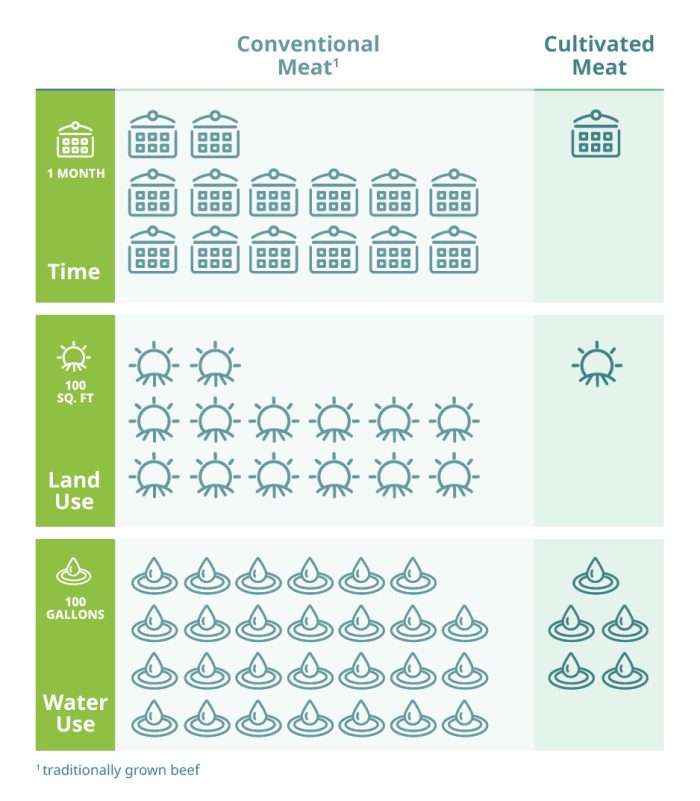
Figure 1. Cultivated meat is estimated to lessen land and water usage with shorter production times. Data based on using 2900 gallons of water, 1345 square feet of land, and 14 months to produce 1lb of traditionally grown beef. Reductions based on life-cycle analysis with a reduction in land usage of 99% and water usage of 82% (Tuomisto and Teixeira de Mattos, 2011). Time to produce cultivated meat based on 45 days from start to harvest (Post, 2020b).
Sustainability and lessened environmental strain are attractive benefits of cultivated meat; the exact impact will depend on the life-cycle of the product. Outside of terrestrial livestock farming, our oceans are under immense pressure from overfishing and climate change. Cultivated meat from fish and shellfish offer sustainable options to help lessen the strain on ocean ecosystems.
How is cultivated meat made?
The science of growing the cells and organized tissues for cultivated meat is rooted in cell biology, bioprocessing and tissue engineering. The first step begins with cell selection and development. This is critical for the success of cultivated meat since the cells need to grow quickly to high concentrations, be stored and re-used indefinitely, adapted to serum-free media, and differentiate into muscle or fat tissue (Stephens, 2018; Post, 2020a). In general, cell lines will be created from adult stem cells. Adult stem cells are different from embryonic stem cells, they can be isolated from a tissue biopsy, a harmless procedure that removes cells from an adult animal.
Next, the chosen cell line is grown under appropriate conditions allowing them to replicate or grow; 0.5g of cells can achieve 2000 kg of meat in 45 days of culturing (Post, 2020b). This often starts at bench scale using petri dishes or flasks and scaled up to larger, well-controlled bioreactors. Once the target concentration is reached, the cells undergo differentiation or transition into muscle or fat cells. The cells can either be harvested in a “free state” or continue to organize into tissues. Under the appropriate conditions, tissues can be guided towards organized 3D structures of fibers, cartilage, blood vessels using tissue engineering approaches to create a food product like steak, chicken breast, salmon filet, lobster claws, etc.
Is cultivated meat the same as conventionally grown meat?
At the cellular level, cultivated meat is identical to conventionally grown meat. It isn’t synthetic meat or lab-grown meat but rather is meat grown outside of the animal. Theoretically, adult stem cells can grow and differentiate into organized tissues that would be identical to a cut of steak, chicken breast, etc. While this is the ultimate end-goal, minimal viable products (MVP) first entering the marketplace will likely be made from cells harvested as a protein/fat-rich ingredient and formulated with other ingredients into a final meat-based product (Stephens et al., 2018).
Using this approach, integration of food science and cell culture bioprocessing will be key to develop familiar, nutritious products acceptable to consumers. Considerations for creating cultivated meat products would be ensuring the products have similar sensory properties to existing foods on the market. From a nutritional standpoint, cultivated meat could be made healthier. An example would be tailoring the fatty acid profile of fat cells to include polyunsaturated fatty acids or modifying the cell to make antioxidants such as carotenoids (Stout et al., 2020). Formulating with other ingredients such as plant-based proteins and fats, emulsifiers, stabilizers, and flavors can be used to create acceptable products. A general overview of the production process is shown in Figure 2.
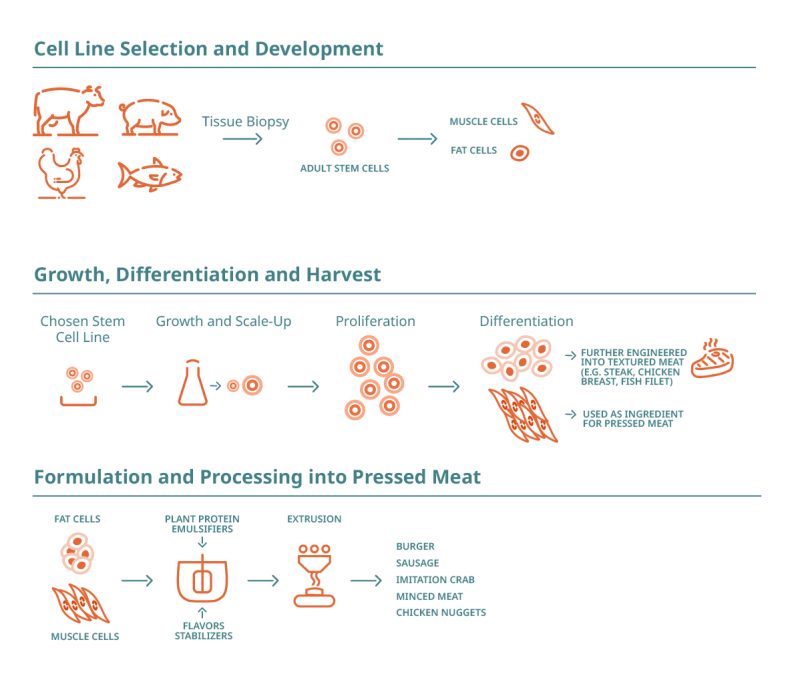
Figure 2. Hypothetical cultivated meat production scheme. This image is a generalisation and may not reflect the actual technologies and approaches being used for cultivated meat development.
Will it ever be a reality?
In 2013, Mark Post proved that cultivated meat was possible. Now over 70 start-ups have emerged with greater than $355 million dollars invested and more than 15 cultivated meat products being pursued (Bryne et al. 2020). With the recent historical commercialization of Eat Just’s GOOD Meat cultured chicken nuggets being sold for ~$20 at 1880 restaurant in Singapore, cultivated meat is now a reality. This is certainly very exciting but there are still serious challenges that lie ahead.
Consumer acceptance is going to be critical for the success of cultivated meat products (Tomiyama et al, 2020). Important considerations for consumer acceptance include price, taste and safety (Crosser et al. 2019). MVPs first entering the market will likely rely on first adopters willing to pay higher prices, open to try novel foods, while late adopters will rely on familiarity once more culturally accepted.
Manufacturing cultivated meat to replace conventionally grown meat will be one of the greatest human achievements to date. According to some, large scale manufacturing won’t be possible due to many unknowns and costly challenges (Fassler, 2021; Humbird 2021):
- Proposed scale of production has never been done before
- Cost and availability of nutrient media and growth factors
- Novel engineering strategies needed to achieve target cell numbers
- Prevention of microbial and viral contamination
Historically, cell culture has been used by the pharmaceutical industry to make high-value drugs in limited quantities compared to quantities needed for cultivated meat, which will require a production scale larger than anything ever done before to produce cultivated meat at $10-20/kg. One facility is estimated to require about one third of the bioreactor volume capacity that currently occupies the entire biopharmaceutical industry (Fassler, 2021). To achieve high cell concentrations, strategies to supplement additional oxygen, remove waste-products, and prevent mixer shear stress are needed. Additionally, the cost of the nutrient media used to grow the cells is another important consideration. Fetal bovine serum has traditionally been used as a nutrient source, but it is expensive and derived from animals. Many start-ups are working on replacing serum and lowering media costs with cheaper, animal-component-free sources (e.g. plant protein hydrolysates). Keeping the bioreactors free from contamination also needs to be considered and will likely require usage of costly clean rooms.
Final Thoughts
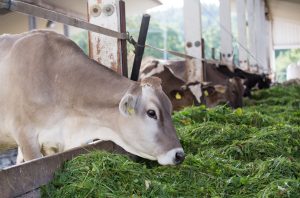 The meat industry is a $1.7 trillion market with the global demand expected to increase with our growing population (Byrne et al. 2020). The cultivated meat industry has an opportunity to capitalize on this massive demand, even 1% would lend huge payouts. While the industry is still novel with many uncertainties ahead, there is much potential. Collaborative partnerships will be critical for commercial success; start-ups partnering with existing food, ingredient, pharmaceutical and biotech companies. Some start-ups have made much progress with some raising enough capital to build pilot-scale facilities to produce the first MVPs poised to enter the food market. While the future of cultivated meat seems imminent, the scale-up challenges posed by critics cannot be overlooked and require serious consideration. As cultivated meat products enter the marketplace, it’ll be up to consumers to decide its fate.
The meat industry is a $1.7 trillion market with the global demand expected to increase with our growing population (Byrne et al. 2020). The cultivated meat industry has an opportunity to capitalize on this massive demand, even 1% would lend huge payouts. While the industry is still novel with many uncertainties ahead, there is much potential. Collaborative partnerships will be critical for commercial success; start-ups partnering with existing food, ingredient, pharmaceutical and biotech companies. Some start-ups have made much progress with some raising enough capital to build pilot-scale facilities to produce the first MVPs poised to enter the food market. While the future of cultivated meat seems imminent, the scale-up challenges posed by critics cannot be overlooked and require serious consideration. As cultivated meat products enter the marketplace, it’ll be up to consumers to decide its fate.
Acknowledgements from the author:
Special thanks to Daniel Noble, Hans Huttinga, Marleen Wintels, and Alison Rabschnuk for their valuable input and feedback.
Contributor:
-
References
Ben-Arye, Tom, and Shulamit Levenberg. “Tissue engineering for clean meat production.” Frontiers in Sustainable Food Systems 3 (2019): 46.
Byrne, B. et al. Cultivated Meat: 2020 State of the Industry Report. Washington: The Good Food Institute. Retrieved from https://gfi.org/resource/cultivated-meat-eggs-and-dairy-state-of-the-industry-report/
Crosser, N. et al. Cultivated Meat: 2019 State of the Industry Report. Washington: The Good Food Institute. Retrieved from https://gfi.org/wp-content/uploads/2021/01/INN-CM-SOTIR-2020-0512.pdf
Fassler, Joe. “Lab-grown meat is supposed to be inevitable. The science tells a different story.” (thecounter.org) http://thecounter.org/lab-grown-cultivated-meat-cost-at-scale
Gerber, Pierre J., et al. Tackling climate change through livestock: a global assessment of emissions and mitigation opportunities. Food and Agriculture Organization of the United Nations (FAO), 2013.
Humbird, David. “Scale‐up Economics for Cultured Meat.” Biotechnology and Bioengineering 118 (2021): 3239-3250.
Post, Mark J., et al. “Scientific, sustainability and regulatory challenges of cultured meat.” Nature Food 1.7 (2020a): 403-415.
Post, Mark. “Cultivated Meat Webinar with Prof. Mark Post”. YouTube, uploaded by The Good Food Institute Israel, 19 May 2020b, https://www.youtube.com/watch?v=R8P_5REK5Do&t=1479s.
Stephens, Neil, et al. “Bringing cultured meat to market: Technical, socio-political, and regulatory challenges in cellular agriculture.” Trends in food science & technology 78 (2018): 155-166.
Stout, Andrew J., et al. “Engineering carotenoid production in mammalian cells for nutritionally enhanced cell-cultured foods.” Metabolic engineering 62 (2020): 126-137.
Tomiyama, A. Janet, et al. “Bridging the gap between the science of cultured meat and public perceptions.” Trends in Food Science & Technology (2020).
Tuomisto, Hanna L., and M. Joost Teixeira de Mattos. “Environmental impacts of cultured meat production.” Environmental science & technology 45.14 (2011): 6117-6123.
Van Boeckel, Thomas P., et al. “Reducing antimicrobial use in food animals.” Science 357.6358 (2017): 1350-1352.

 Kyle Probst, PhD has over 7 years of experience working in an industrial research and development role for bioprocess development, food formulation and microbial fermentation. He has practical expertise in experimental design, data analysis, scientific writing and communicating science-related topics to broad audiences.
Kyle Probst, PhD has over 7 years of experience working in an industrial research and development role for bioprocess development, food formulation and microbial fermentation. He has practical expertise in experimental design, data analysis, scientific writing and communicating science-related topics to broad audiences. 